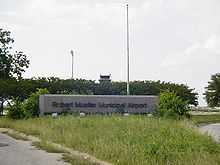Robert Mueller Municipal Airport
| Robert Mueller Municipal Airport | |||||||||||
|---|---|---|---|---|---|---|---|---|---|---|---|
 Former airport entrance | |||||||||||
|
IATA: | |||||||||||
| Summary | |||||||||||
| Airport type | Public, Defunct | ||||||||||
| Operator | City of Austin | ||||||||||
| Serves | Greater Austin Area | ||||||||||
| Location | Austin, Texas, U.S. | ||||||||||
| Opened | October 14, 1930[1] | ||||||||||
| Closed | May 21, 1999[2] | ||||||||||
| Elevation AMSL | 632 ft / 193 m | ||||||||||
| Coordinates | 30°18′00″N 097°42′00″W / 30.30000°N 97.70000°WCoordinates: 30°18′00″N 097°42′00″W / 30.30000°N 97.70000°W | ||||||||||
| Map | |||||||||||
 AUS Location within Texas | |||||||||||
| Runways | |||||||||||
| |||||||||||
| Statistics (1998) | |||||||||||
| |||||||||||
|
Source: Passengers from The Daily Texan[3] | |||||||||||
Robert Mueller Municipal Airport (/ˈmɪlər/ MILL-ər) was the first civilian airport built in Austin, Texas, operating from 1930 to 1999. It was replaced as Greater Austin's main airport by the Austin Bergstrom International Airport.[2] Located a few miles northeast of downtown Austin, the airport was named after Robert Mueller, a city commissioner who had died in office in January 1927.[4][5]
History
As the need for commercial air service became clear in the 1920s, Austin voters supported a bond election to build a municipal airport in the city in 1928. The airport was constructed a few miles northeast of downtown, on what was then the edge of the city. The airport began operation on 14 October 1930, although commercial service would not begin until 1936.[1]
In the 1950s, developers began building residential areas beneath the flight paths of Mueller and, in parallel, the number of arrivals and departures at the airport increased dramatically because of the growth of the city. The April 1957 OAG shows 33 weekday airline departures: 15 Braniff, 10 Trans-Texas and 8 Continental. No nonstops flew beyond San Antonio, San Angelo, Dallas and Houston. The first scheduled nonstop beyond Texas was a Braniff 727 to Washington Dulles in 1968; that flight lasted until 1980. It was the only nonstop out of the state until Braniff tried a Chicago nonstop in 1978.
Expansions
A new passenger terminal and control tower were built in 1961. The control tower was known for its alternating light blue and dark blue porcelain panels. The terminal and control tower were dedicated in a ceremony attended by Vice President Lyndon B. Johnson and Austin Mayor Lester Palmer.[4]
A major expansion at Mueller took place in the 1970s, including improvements to the runways and the terminal. Before the expansion, the departure area consisted of 4 to 5 gates, not enclosed but covered by a large awning; no jetways were present at the time.[6] Mueller's longest runway was 7,000 feet (2,100 m) long, and by the late 1990s the passenger terminal was operating at full capacity with 16 gates.
For a number of years, the Texas Army National Guard had facilities there.
Closure and replacement
Whether the aging Mueller should be relocated to Manor, Texas, was a perennial issue in Austin politics, until the closure of Bergstrom Air Force Base opened another possibility.[7]
Nearby Bergstrom Air Force Base closed as an active military base in 1993, and it was decommissioned as a reserve base in 1996.[8] It was refurbished into a civilian airport to replace Mueller Airport.[8]
Mueller Airport's commercial service ended on 21 May 1999, replaced by Austin Bergstrom International Airport;[2] general aviation continued through 22 June.[9]
Redevelopment as Mueller Community
The 711 acres (3 km2)[10] of land that once housed the airport sat vacant and unused for more than half a decade until the city finally approved a development plan. The new Mueller Community broke ground in 2007 and is expected to take at least ten years to be fully developed.
It is the current location for Robert Rodriguez's production company, Troublemaker Studios.
References
- ↑ 1.0 1.1 Ragsdale, Kenneth Baxter (2007). Austin, Cleared for Takeoff: Aviators, Businessmen, and the Growth of an American City. p. xi.
- ↑ 2.0 2.1 2.2 "Service Begins at New Austin Airport". Los Angeles Times. May 24, 1999. p. 2.
- ↑ "New airport prepares to take off More flights? Maybe. More traffic? Probably.". The Daily Texan. February 3, 1999.
- ↑ 4.0 4.1 Slate, John H. (November 26, 2012). Lost Austin. Arcadia Publishing SC. p. 21. ISBN 9780738596136.
- ↑ "Why was Austin's first municipal airport named Mueller Airport?". Austin Public Library. Retrieved February 3, 2015.
- ↑ "Mueller Airport". Austin Explorer. Retrieved August 28, 2011.
- ↑ "Airport site stirs controversy". The Daily Texan. January 15, 1985.
- ↑ 8.0 8.1 "For Austin, Texas, Old Air Force Base Becomes City Airport". The Wall Street Journal. May 24, 1999.
- ↑ "Austin aviation gets new home at converted air base". Associated Press (Lubbock Avalanche-Journal). May 24, 1999.
- ↑ Lyman, Rick (April 11, 1999). "Austin, in the Big Time, Gets an Airport to Match". The New York Times. p. 3.
External links
 Media related to Robert Mueller Municipal Airport at Wikimedia Commons
Media related to Robert Mueller Municipal Airport at Wikimedia Commons- Mueller Master Developer Site
- Airport diagram for April 1986